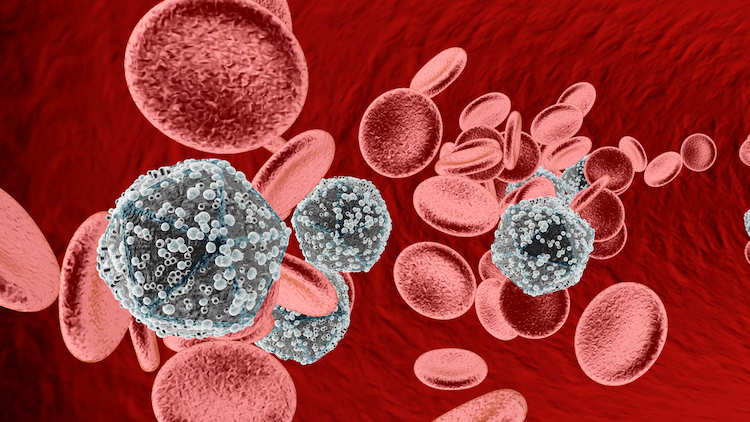When patients take HIV medication, a small amount of the virus nonetheless stays hidden in the body, preventing a cure. This hiding place has finally been uncovered in a groundbreaking study led by UZ Gent researchers. With this ‘viral reservoir’ identified, researchers may finally be able to develop a cure for this devastating disease.
By Amy LeBlanc
Living with a lurking threat
Imagine you had a deadly virus lingering in your body. You take a pill every day to keep the virus at bay, but it’s always there: a constant lurking threat from which you cannot break free.
This is the troubling reality for the 37 million HIV positive people around the world today, including 1.8 million children. For all the breakthroughs in HIV treatment over the past few decades, we still have not been able to find a cure for the tenacious disease.
HIV patients have to rely on antiviral medication that suppresses the virus; patients are not infectious or symptomatic, but they remain infected. If they lose access to their medication or stop taking it, the virus will return in full force. By affecting the immune system, these antiviral drugs also put patients at risk of other conditions like cardiovascular disease and cancer.
“HIV is hiding in specific immune cells in the body and therefore remains under the radar. When the patient stops taking inhibitors, the virus can come back from these cells and cause the virus to flare up in a viral rebound.” – Dr. Marie-Angelique De Scheerder and Prof. Linos Vandekerckhove, UZ Gent.
Scientists have long been looking for an actual cure to HIV, so that patients will be free from the physical, mental and financial burden of constant medication. One of the main obstacles to a true cure has been the ‘viral reservoir’ that remains when patients take antiviral medication. To truly cure a person of HIV, these final bastions of disease need to be eliminated; to do that, we need to know where they are.
Finding the needles in the haystack
Thanks to a groundbreaking Belgian study, we are now much closer to finding a cure for HIV. A team of researchers at UZ Gent, led by Dr. Marie-Angelique De Scheerder and Prof. Linos Vandekerckhove, have rooted out the HIV hiding place. As it turns out, the HIV virus manages to lie low in many different organs and cell types throughout the body, which is why this viral reservoir is so hard to eliminate.
“Contrary to what people previously thought, our research has shown that many different immune cells are partly responsible for this viral reservoir. We demonstrated that the viral rebound does not come from one specific organ or cell type but can come from different cell types and body parts such as blood, lymph nodes and intestinal tissue. We have succeeded in mapping ‘the enemy’.” – Dr. Marie-Angelique De Scheerder and Prof. Linos Vandekerckhove, UZ Gent.
This breakthrough was only made possible by the 11 patients who discontinued their HIV medication as part of the study (their medication was restarted as soon as the virus flared up). The study involved twice-weekly checkups as well as painful and invasive sampling procedures, such as bone marrow and lymph node biopsies. Their sacrifice has provided the world with valuable insights into this devastating disease.
In addition to identifying the hiding places of the residual HIV virus, the UZ Gent team were able to analyze how rapidly the virus flares up when patients go off their medications. The study showed that the virus is very quick to return, resurging after just 14-35 days.
“It proves once again how important it is for HIV patients to take their medication consistently,” said Vandekerckhove. “Because without medication, the virus strikes again quickly.”
A hope for a cure
The discovery that the HIV virus stays hidden throughout the body, in different tissues and organs, is not a positive finding in itself. Eradicating this viral reservoir will be tough. To cure HIV, scientists must develop a therapy that either targets all these different hiding places at once or combine different therapies that kill the residual virus off together.
Fortunately, there is already a starting point: CAR T-cell therapy. This therapy is just the kind of targeted whole-body approach that might be able to root out the virus, once and for all. At UZ Gent, the researchers are hopeful that this sort of immunotherapy might sway the tide. The hospital is planning the first patient tests within the next year and a half.
Would an HIV cure be a solution for the 37 million HIV patients worldwide? Currently, that appears unlikely. In addition to logistical and financial issues, immunotherapies like CAR T are complex and not without their own risks and side effects. The clinical trials alone would likely take the better part of the next decade to complete.
Nevertheless, pharmaceutical companies are sitting up and taking notice. After this study was published, the authors were contacted by US pharma giant Gilead within just 24 hours. Gilead is one of the foremost producers of HIV medication in the world, with over 12.5 million people currently receiving their HIV therapies; the company clearly has a vested interest in a potential cure. With the results of this study, we are now closer than ever to creating a cure for HIV.


